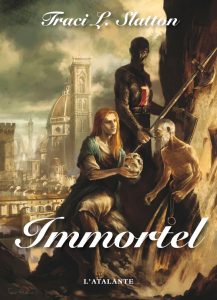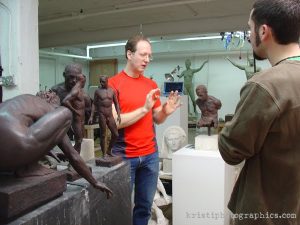5 Ways to Engage Your Kids in Art and History
5 Ways to Engage Your Kids in Art and History
 We (parents) want them (kids who know everything about instant messaging and the latest celebrity rehab, but who run screaming from museums and art books) to grow up knowing about more than Wii and the Xbox. We aspire for them to become literate, cultured people who can say something meaningful about Michelangelo’s Pieta and Degas’ dancers.
We (parents) want them (kids who know everything about instant messaging and the latest celebrity rehab, but who run screaming from museums and art books) to grow up knowing about more than Wii and the Xbox. We aspire for them to become literate, cultured people who can say something meaningful about Michelangelo’s Pieta and Degas’ dancers.
My husband is a classical figurative sculptor, and I have a passion for Renaissance art that led me to write a historical novel set in Renaissance Florence. So we have been determined to instill some love of art in our four children, despite their resistance. Here are some of our strategies.
- Make a game out of a museum trip. Go to the gift shop first, and let each child select four or five postcards. Then hunt through the museum to find all the paintings or sculptures shown on the cards. The first to find all of his objets d’art wins. But they all get treats at the end.
- Turn holiday meals into mini art salons. This works better in the winter, when we’re indoors. At summer cookouts, there’s too much else that’s intriguing. Not even the appearance of Leonardo da Vinci himself, resurrected and in the flesh, would engage a kid when cheeseburgers sizzle on the grill and sprinklers splutter on the lawn. But at Thanksgiving, for example, each person has to bring a poem, or a picture or printout of a painting or sculpture to the table. Before I serve the first course, we each read our poem or show the picture and talk about why we chose it. My kids like the attention, and they like being the teacher for the moment.
- Have a family culture night each week, and let each child in turn lead the weekly discussion. Assign a topic, such as Impressionist Painters or Robert Frost’s poetry. Older children can choose their topic, perhaps arising from a homework assignment. This also capitalizes on kids’ innate love of attention and being the leader. Thursday night is usually our family dinner night, and while the older three of the four girls in our blended family spend a lot of time discussing mascara and hot guys, they also try to find something interesting to say about Charles Dickens or Gustave Courbet.
- Give them a get-out-of-jail-free card. If the girls spontaneously engage in a cultural activity, like perusing an art book that’s not assigned at school, or watching a television documentary about World War II or the life of Chagall, they may get a free “pass.” My kids do the boneheaded things all kids do, and they love this, especially when they haven’t cleaned their room in two months and are growing non-CDC-approved life forms in old pizza boxes (not the kind of culture we advocate). Note: this is best used for minor mischief. When my daughter got drunk at age 16, not even a four-hour discourse on Cimabue and Giotto could have gotten her off the hook. Responsible behavior means responsible behavior.
- Find an artist nearby and take your kids on a studio visit. Many artists enjoy having visitors to witness their process, and seeing a live person passionately engaged in artistic endeavor is the sneakiest way to spark a young mind. A painter in love with his art, or a musician in love with his instrument, is a thrilling inspiration. It’s best if the artist is at least semi-successful so the kids see the business acumen that goes along with a thriving career in the arts. After all, they will have to earn a living one day.
It’s not a perfect system, built as it is mostly on attention-based bribery and cajolery. And truly, the best way to teach kids to seek high culture, as with any other value, is for parents to embrace it themselves. That’s a tall order when we’re beset with carpooling to soccer games, overseeing homework, cooking, housecleaning, jobs, and the need to sleep a few hours each night. But with love, tolerance, and a sense of humor, we can encourage our kids to appreciate beautiful art.
FROM: new jersey family, february 2010.






